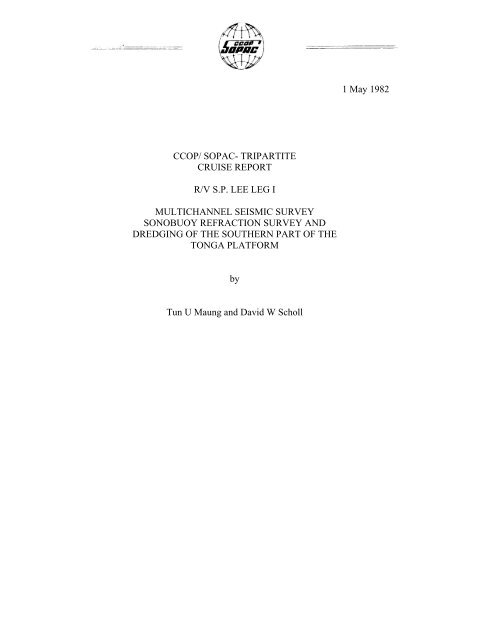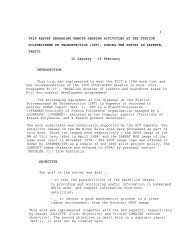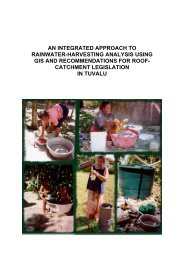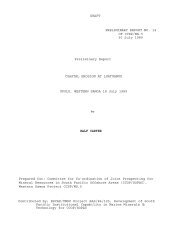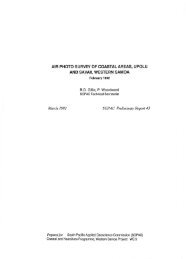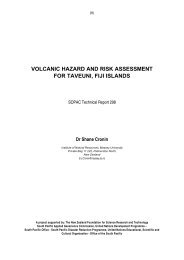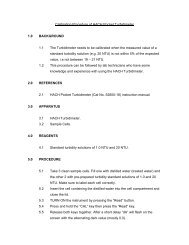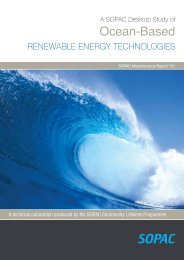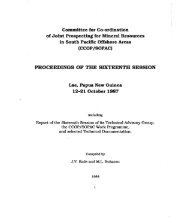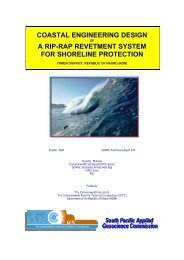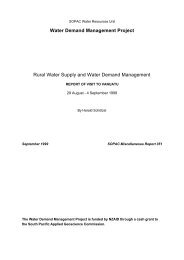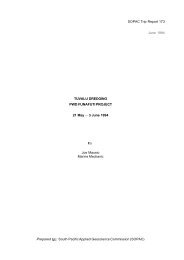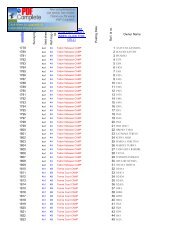Multichannel seismic survey sonobuoy refraction survey and ...
Multichannel seismic survey sonobuoy refraction survey and ...
Multichannel seismic survey sonobuoy refraction survey and ...
You also want an ePaper? Increase the reach of your titles
YUMPU automatically turns print PDFs into web optimized ePapers that Google loves.
CCOP/ SOPAC- TRIPARTITE<br />
CRUISE REPORT<br />
R/V S.P. LEE LEG I<br />
MULTICHANNEL SEISMIC SURVEY<br />
SONOBUOY REFRACTION SURVEY AND<br />
DREDGING OF THE SOUTHERN PART OF THE<br />
TONGA PLATFORM<br />
by<br />
Tun U Maung <strong>and</strong> David W Scholl<br />
1 May 1982
INTRODUCTION<br />
This <strong>survey</strong> was undertaken as part of the Joint Programme 01 Marine Geoscientific<br />
Research <strong>and</strong> Mineral Resources Studies of the South Pacific Region sponsored by Australia,<br />
New Zeal<strong>and</strong> <strong>and</strong> the United States of America with the cooperation of CCOP/ SOPAC. The<br />
USGS research vessel SAMUEL P.LEE was used for this <strong>survey</strong>.<br />
Prior to this <strong>survey</strong>, fourteen E-W <strong>and</strong> one N-S single-channel <strong>seismic</strong> reflection<br />
profiles were acquired by CCOP /SOPAC in 1979 totaling 2140km. Also, the southern part<br />
of the Tonga Platform was traversed by EVA III, GEORSTOM <strong>and</strong> AUSTRADEC scientific<br />
expeditions in 1977 <strong>and</strong> 1978 organized by ORSTOM <strong>and</strong> had acquired 12 single-channel<br />
<strong>seismic</strong> <strong>and</strong> magnetic profiles. Based on these data <strong>and</strong> the existing oil company data<br />
available at the Ministry of L<strong>and</strong>s, Survey <strong>and</strong> Natural Resources, Nuku'alofa, Tonga, an<br />
"Assessment of the Petroleum Potential of the southern <strong>and</strong> northern parts of the Tonga<br />
Platform'' was prepared by CCOP/ SOPAC. This <strong>survey</strong> is the outcome of the<br />
recommendations made in that report.<br />
CRUISE OBJECTIVES<br />
The objective 01 this <strong>survey</strong> was, to gather multi-channel <strong>seismic</strong>, single channel<br />
<strong>seismic</strong>, gravity, magnetic, <strong>and</strong> <strong>sonobuoy</strong> <strong>seismic</strong>: <strong>refraction</strong> data <strong>and</strong> to dredge for rock<br />
samples over the southern part of the Tonga Platform south of Tongatapu <strong>and</strong> 'Eua up to<br />
approximately Longitude 23° 3D', It is envisaged that the analysis of these data will provide a<br />
better elucidation of the sub sea-bed geology (sedimentary rocks thicknesses <strong>and</strong> structures)<br />
<strong>and</strong> tectonics than the existing single-channel <strong>seismic</strong> data in order to assess the petroleum<br />
potential of this portion of the southern part of the Tonga Platform.<br />
It was also decided to gather single-channel <strong>seismic</strong>, magnetic <strong>and</strong> gravity data from<br />
Pago Pago, American Samoa enroute to Nuku'alofa, Tonga <strong>and</strong> from around 'Eua (at the end<br />
of multi-channel work <strong>and</strong> dredging) enroute to Suva, Fiji, in order to provide additional data<br />
to the studies of sub sea-bed geology <strong>and</strong> tectonics of the northern part of the Tonga Platform<br />
<strong>and</strong> Lau basin <strong>and</strong> ridge respectively.
PERSONNEL PARTICIPATING<br />
David Scholl Co-Chief Scientist, USGS Marine Geologist<br />
Tun U Maung Co-Chief Scientist, CCOP/SOPAC Petroleum Geologist<br />
Neville Exon Bureau of Mineral Resources, Australia; Marine<br />
Geologist<br />
Richard Herzer New Zeal<strong>and</strong> Geological Survey, New Zeal<strong>and</strong>;<br />
Petroleum Geologist<br />
Mark S<strong>and</strong>strom Australian National University, Australia; Organic<br />
Geochemist<br />
Sione Soakai Ministry of L<strong>and</strong>s, Survey <strong>and</strong> Natural Resources,<br />
Kingdom of Tonga<br />
Other participants from USGS were:<br />
Robert Rowl<strong>and</strong> Branch Chief, Pacific-Arctic Branch of Marine<br />
Geology - multi channel<br />
Tracy Vallier Chief of Watch<br />
Andrew Stevenson Chief of Watch<br />
Dennis Mann <strong>Multichannel</strong><br />
Jon Childs Sonobuoy <strong>seismic</strong> <strong>refraction</strong><br />
Graig McHendrie Navigator<br />
Kay Kinoshita Navigator<br />
Barbara Seekins Navigator<br />
Chris Gutmacher <strong>Multichannel</strong><br />
Larry Kooker Electronic Technician<br />
George Asuncion Electronic Technician<br />
Jeff Rupert Marine Technician<br />
Hal Williams Marine Technician<br />
2<br />
EQUIPMENT AND FACIUTIES<br />
The <strong>survey</strong> was conducted by the USGS research vessel SAMUEL P. LEE, a 208foot,<br />
1300-ton vessel, equipped with a full complement of marine geophysical equipment<br />
integrated in such a fashion so as to allow the simultaneous collection of multichannel<br />
<strong>seismic</strong> reflection, single-channel <strong>seismic</strong> reflection, <strong>sonobuoy</strong> <strong>seismic</strong> <strong>refraction</strong>, gravity,<br />
magnetic <strong>and</strong> bathymetric data. Also the vessel is capable of dredging <strong>and</strong> gravity coring. The<br />
equipment used are as follows:
(1) Navigation Equipment:<br />
Magnavox Integrated System MX-702A <strong>and</strong> MX-II05.<br />
Edo Western doppler sonar<br />
(2) Bathymetric Equipment:<br />
Raytheon Line Scan Recorders with 3.5kHz <strong>and</strong> 12kHz transducers<br />
(3) Gravity Equipment:<br />
La Coste & Romberg S-53 sea gravity meter<br />
La Coste & Romberg G-426 l<strong>and</strong> gravity meter for l<strong>and</strong> ties at Pago Pago,<br />
Nuku'alofa <strong>and</strong> Suva<br />
(4) Magnetic Equipment:<br />
Geometrics proton magnetometer G801g<br />
(5) Single-channel Seismic Equipment:<br />
Raytheon Line Scan R"corder<br />
100-metres long Teledyne streamer<br />
95 or 148 cu.inch airgun<br />
(6) <strong>Multichannel</strong> Equipment:<br />
Globe Universal Sciences Model HDDR 4200 amplifer <strong>and</strong> HDDR 2000 Tape<br />
recorder<br />
Two Raytheon Line Scan Recorders <strong>and</strong> SIE dry write camera 2400 meters long<br />
Seismic Engineering streamer<br />
5 airguns with total capacity of 1313 cu.inch.<br />
(7) Seismic Refraction Equipment:<br />
Fairfield Select Inc. amplifiers <strong>and</strong> Hewlet-Packard 3968A tape recorder Two<br />
Raytheon Line Scan Recorders<br />
SQS 418 Navy <strong>sonobuoy</strong>s (52 Nos deployed)<br />
(8) Dredging <strong>and</strong> Coring:<br />
Chain dredge <strong>and</strong> 3 metre long gravity corer consisting of plastic liner <strong>and</strong><br />
800lbs lead block as weight.<br />
3
4<br />
PRELIMINARY RESULTS<br />
During the <strong>survey</strong> 2357km of multichannel <strong>seismic</strong> data were recorded. Concurrently,<br />
single-channel <strong>seismic</strong>, gravity <strong>and</strong> magnetic data were also recorded. In addition, 2176km of<br />
single-channel <strong>seismic</strong> data together with gravity <strong>and</strong> magnetic data were recorded; 719km north<br />
of Tongatapu between Pago Pago <strong>and</strong> Nuku’alofa; <strong>and</strong> 1457 south of Tongatapu while in transit<br />
to various dredge-sites. The multichannel <strong>seismic</strong> track lines <strong>and</strong> the locations of <strong>sonobuoy</strong><br />
deployment from <strong>sonobuoy</strong> Nos. 5-49 are shown in Figure 1. The multichannel line Nos. 10 <strong>and</strong><br />
11 tie with the DSDP well site 203. Also, more than 750m of single-channel <strong>seismic</strong>, gravity <strong>and</strong><br />
magnetic data were recorded in transit from the last dredge-site D9 about 30km SW of 'Eua to<br />
Suva with the objective of gathering more data in studying the Lau basin <strong>and</strong> ridge.<br />
The three probable reefal buildups identified from the CCOP/SOPAC Line N-O were also<br />
observed on the single-channel <strong>seismic</strong> record of E-W Line No. 11. One of the reefal buildups,<br />
most likely the one in the centre, was also observed on the single-channel <strong>seismic</strong> record of N -5<br />
Line No. 14. These establish the presence of probable reefal buildups in that area. No other<br />
obvious reefal buildups were observed on any other single-channel <strong>seismic</strong> records.<br />
In most of the lines, especially on Line Nos. 3-8, the sedimentary beds appear to thicken<br />
from east to west from about 0.5 to 1.5 sec. to over 3.0 sec. (about 5600m). Angular<br />
unconformities are observed at about 0.2-0.5 sees. <strong>and</strong> the sedimentary beds below the<br />
unconformity apparently dip westwards; the dips are found to be very gentle. Many normal<br />
faults, some of which are active up to recent times are observed on the single-channel <strong>seismic</strong><br />
sections. Magnetic anomalies are observed over the Pleistocene-recent volcanic trend <strong>and</strong> where<br />
the probable shallow basement is believed to exists.<br />
Some of the <strong>sonobuoy</strong> graphic records were analyzed on board using the digitizing table<br />
<strong>and</strong> a desktop computer. Preliminary results of a few <strong>sonobuoy</strong> <strong>refraction</strong> profiles are included as<br />
Appendix 8.<br />
Locations for dredging <strong>and</strong> coring were chosen by the participating scientists in<br />
consultations with the Co-Chief Scientists, by studying the Polaroid photographs (pasted together<br />
to form a continuous strip for each line) of the single-channel <strong>seismic</strong> data. Though several<br />
attempts to core were made on 6 or 7 sites chosen from the single-channel <strong>seismic</strong> data, none<br />
successfully penetrated more than a few cm due to the hard seabed surface encountered.
5<br />
Also, 18 sites were chosen dredging from the single-channel <strong>seismic</strong>' data, but only 9<br />
sites were actually dredged. Many of the remaining sites had to be ab<strong>and</strong>oned due to the<br />
alteration of arrival time in Suva by about 12 hours ahead of schedule. The latitudes <strong>and</strong><br />
longitudes <strong>and</strong> water depths of the dredge sites arc given in Appendix C <strong>and</strong> the locations are<br />
shown in Figures 2(a) <strong>and</strong> 2(c). A short preliminary description of the dredge samples recovered<br />
are given in Appendix I).<br />
CONCLUSIONS AND RECOMMENDATIONS<br />
Except for dredging, the programme was completed as planned. The area <strong>survey</strong>ed -<br />
between Tongatapu <strong>and</strong> latitude 23° 30' on tile southern part of the Tonga Platform - appears to<br />
have sufficient thicknesses <strong>and</strong> areal extent of sedimentary rocks below the seabed to constitute<br />
an area of potential for accumulation of petroleum. The presence of possible reefal buildups is<br />
confirmed by this <strong>survey</strong>. Also, it is likely that there are many fault <strong>and</strong> stratigraphic traps.<br />
The multichannel <strong>seismic</strong> data after proper processing together with <strong>sonobuoy</strong> <strong>refraction</strong><br />
data may indicate the presence of more reefal buildups. It is recommended that a thorough<br />
interpretation of all the data gathered during the present <strong>survey</strong>, i.e. multichannel <strong>seismic</strong>,<br />
single-channel <strong>seismic</strong>, gravity, magnetic <strong>and</strong> <strong>sonobuoy</strong> <strong>refraction</strong> data be made in conjunction<br />
with the results of the source rock investigation team of USGS which will visit Tonga in the<br />
near future, be made to assess properly the petroleum potential of the <strong>survey</strong>ed area<br />
WORK REMAINING<br />
Data reduction <strong>and</strong> computer processing of all data gathered during the <strong>survey</strong> in Menlo<br />
Park, California, by the Marine Geology Processing Centre of U.S. Geological Survey. The<br />
processed multichannel <strong>and</strong> single-channel data are to be displayed in a 9-inch Mylar base<br />
transparency. Processed gravity <strong>and</strong> magnetic data are also to be displayed on a 9-inch Mylar<br />
base transparency at the same horizontal scale i.e. with the same shot-point spacing, so that the<br />
available sets of data can be readily pasted together for interpretation.<br />
REFERENCES<br />
Dupont, J. in press: Morphologie et structures superficielles de l'arc insulaire des Tonga-<br />
Kermadec, in Equipe de Geologie-Geophysique du Centre ORSTOM de Noumea.<br />
Contribution a l'etude geodynamique du Sud-Ouest Pacifique. Travaux et Documents de<br />
PORSTOM No. ___. 20pp.
Gauss, G.A., 1979: Tonga offshore <strong>survey</strong> 1-17 November 1979 Cruise TG-79-1.<br />
CCOP/SOPAC Cruise Report No. 33, 3pp. 1 figure, 2.appendices.<br />
6<br />
Maung, T.U., Anscombe, K., <strong>and</strong> longilava, S.L., 1981: Assessment of Petroleum Potential<br />
of the southern <strong>and</strong> northern parts of the Tonga Platform. CCOP / SOPAC Technical<br />
Report No. 18, 43pp. 5 appendices, 12 figures.
Appendix A: Narriltive<br />
LIST OF APPENDICES<br />
Appendix B: Pre1irninilry results of a few <strong>sonobuoy</strong> <strong>refraction</strong> <strong>survey</strong>s<br />
Appendix C: Locations of Dredge Sites<br />
Appendix D: A short preliminary description of the dredge samples recovered.<br />
LIST OF FIGURES<br />
Figure 1: Map showing multichannel <strong>seismic</strong> track lines <strong>and</strong> location; of<br />
<strong>sonobuoy</strong> deployment.<br />
Figure 2(a): Map showing dredge sites D-l to D-5<br />
Figure 2(b): Map showing dredge sites D-6 to D-8<br />
Figure 2(c): Map showing dredge site D-9
APPENDIX A<br />
NARRATIVE<br />
1800hrs GMT 26 March R/V S.P. LEE arrive Pago Pago, American Samoa<br />
0000hrs GMT 28 March R/V S.P. LEE depart Pago Pago, American Samoa<br />
0030hrs GMT 31 March R/V S.P. LEE arrive Nuku'alofa, Tonga<br />
0500hrs GMT 2 April R/V S.P. LEE depart Nuku'alofa, Tonga<br />
0830hrs GMT 2 April Start multichannel <strong>seismic</strong> <strong>survey</strong> on Line No.3<br />
2000hrs GMT 13 April End multichannel <strong>seismic</strong> <strong>survey</strong> on Line No. 18.<br />
1609hrs GMT 14 April Dredging on dredge-site D-1 on <strong>seismic</strong> Line No. 11.<br />
The period between end of multichannel sun
Dredge Site 0-1<br />
APPENDIX D<br />
SHOR T PRELIMINARY DESCRIPTIONS<br />
OF THE DREDGE SAMPLES RECOVERED<br />
Amount recovered was 21 rocks samples weighing c1bout 301bs. It can be grouped into<br />
four general categories.<br />
Group 1: Volcanic siltstone-breccias. Fragments of siltstones in tan secondary cement -<br />
slightly calcareous; with manganese crusts. 5 specimens.<br />
Group 2: Volcanic siltstone with some interbeds of coarse s<strong>and</strong>, light brown.<br />
One specimen with manganese crust. 11 specimens.<br />
Group 3: Volcanic breccias brown und green, slightly rounded to angular c1asts of mafic<br />
volcanic rocks. 4 specimens<br />
Group 4: 1 piece pumice, approximately 12cm in longest dimension.<br />
Dredge Site D-2<br />
Amount recovered was one rock weighing about 2lbs. One cobble-sized block with one<br />
fresh broken surface. Remaining surface of Ferro-manganese coated less than 1 mm thick.<br />
Dredge Site 0-3<br />
Amount recovered was half dredge bag of rocks, all sedimentary, many of which are<br />
manganese encrusted. It can be grouped into 5 general categories.<br />
Group 1: S<strong>and</strong>stone, grey, coarse grained, poorly sorted, some calcareous matrix with<br />
forams. Distinct bedding on mm <strong>and</strong> cm scale. Weathered angular lithic fragments of feldspar.<br />
Some porosity. Clasts yellow, red <strong>and</strong> grey. Manganese crusts to lcm thick, some diffuse Mn in<br />
matrix. Moderately weathered.<br />
Group 2: S<strong>and</strong>stone, buff to light brownish-grey, medium to coarse grained, very poorly<br />
sorted, calcareous, foraminifera, angular to sub rounded, lithic fragments yellow <strong>and</strong> grey, some<br />
quartz. Heavily weathered feldspar. Some pebble-sized pumice fragments. Manganese crusts to<br />
lcm thick; some diffuse manganese in matrix.<br />
Group 3: Limestone, forarn, cocolith, buff white, hored ½ cm diameter holes.<br />
Minor manganese coatings in borings. Minor volcanic rock, fragments. Weathered.
Group 4: Limestone foraminifera. Extensively bored, interbedded with volcaniclastic<br />
s<strong>and</strong>stones. Borings lined with manganese. Manganese also encrusting sample less than 3mm.<br />
Buff-yellow weathered.<br />
Group 5: S<strong>and</strong>y mudstone, uniform light brown matrix speckled with s<strong>and</strong>-sized altered<br />
volcanic lithic fragments; fairly rare forams. Rare crystals of feldspar, quartz <strong>and</strong> hornblende<br />
granule to pebble-sized m ntmorillonite masses probably representing altered pumice. Pockets of<br />
forams. Manganese coats to lcm thick.<br />
Dredge Site D-4<br />
Amount recovered 21 cobbles of pumice, 1 boulder of pumice <strong>and</strong> I cobble of soft<br />
mudstone.<br />
2<br />
Pumice: Dark to light grey (uniform <strong>and</strong> b<strong>and</strong>ed) unaltered with unfilled vesicles containing<br />
delicate fibers of glass. Flour b<strong>and</strong>ing evident in colors <strong>and</strong> vesicles alignment. Blocks show no<br />
signs of having been buried <strong>and</strong> only one (the boulder) has begun to acquire a Fe Mn stain.<br />
Mudstone: Medium grey brown, soft, weathered, non-bedded, moderately burrowed,<br />
tuffaceous, contains scattered granules of weathered pumice <strong>and</strong> pebble-sized clasts of light brown<br />
<strong>and</strong> medium grey clay which may be altered lapilli. S<strong>and</strong>y looking material is made up of clay<br />
lithic clasts (altered volcanic s<strong>and</strong> or pellets?) <strong>and</strong> rare crystals of feldspar <strong>and</strong> ferrornagnesiuns.<br />
Texture of rock is very poorly sorted (debris flow emplacement?) with pebble-sized clasts<br />
apparently floating in the matrix.<br />
Dredge Site D-5<br />
Full dredge recovered. Rocks up to 45cm across. It can be grouped into 7 categories.<br />
Group l: Calcareous siltstone; light grey-brown, moderately soft, slightly weathered (5%),<br />
poorly sorted, thin to medium bedded with blocky fractures. Stringers of scattered forams. Very<br />
homogeneous.<br />
Group 2: Limestone; white, moderately soft, weathered (20%) poorly sorted (lime mud<br />
tovery fine s<strong>and</strong>). Abundant forams, some boring with manganese veneer, some cross-bedding. No<br />
volcanic detritus. Poorly to moderately bedded.<br />
Group 3: Limestone; yellowish, moderately soft, more weathered (35%), extensively bored<br />
with Mn02 coatings. Some cross-bedding on cm scale. Bedding on scale of mm to cm, volcanic<br />
detritus, poorly sorted (lime mud to s<strong>and</strong> sized). Thin (less than 3mm) Mn02 crusts. Foram-rich,<br />
glauconitic (?). The limestones are gradational to volcaniclastics.
Group 4: Calcareous mudstone with s<strong>and</strong>-sized volcaniclastic granules (2%) <strong>and</strong> coarse<br />
fossil debris (mounlds of pteropods <strong>and</strong> heteropods, <strong>and</strong> small bivalves). Grades into volcanic<br />
limestone <strong>and</strong> calcareous volcanic s<strong>and</strong>stones, with which it is interbedded. Forams present.<br />
3<br />
Group 5: Calcareous volcaniclastic breccia; light grey weathering euhedral pyroxene<br />
crystals. Thinly bedded with calcareous volcanic s<strong>and</strong>stone. Possibly graded. Clasts s<strong>and</strong> sized to<br />
2cm; mainly less than lcm. Angular, occasional forams.<br />
Group 6: Volcanogenic s<strong>and</strong>stome; light brown, weathering yellow (35%), brown, rich in<br />
feldspar <strong>and</strong> lithic fragment, some fragments possibly quartz medium grained clasts with finer<br />
matrix-supported s<strong>and</strong>y mudstone. Calcareous cement. Thin (less than 3mm). Manganese crusts<br />
on upper surfaces. Clasts sub angular to rounded.<br />
Group 7: Grey pumice cobbles QS in earlier stations. Abundant.<br />
Dredge Site 0-6<br />
Recovered full dredge, about 50 rocks <strong>and</strong> some pumice. It can be grouped into 5<br />
categories.<br />
Group 1: Limestone; fine grained pale yellowish brown, thin to medium, good bedding.<br />
Minor boring. Silt to fine s<strong>and</strong>-sized carbonate grains. Some forams. Terrigenous materials<br />
present in some specimens. Some thin managanese coatings. Possibly glauconitic (7) Outer shelf<br />
facies (?)<br />
Group 2: Calcareous siltstone <strong>and</strong> fine s<strong>and</strong>stone; buff to medium greenish-grey, medium<br />
bedding (possibly cross-bedding). Bioturbation in siltstones but no borings. S<strong>and</strong>stone medium<br />
well sorted, texturally <strong>and</strong> mineralogically mature but grains seem to be labile <strong>and</strong> break down to<br />
silt between fingers, <strong>and</strong> therefore probably feldspar rich. Probably shelf to upper slope facies.<br />
Group 3: S<strong>and</strong>stone <strong>and</strong> gritty s<strong>and</strong>stone. Fine s<strong>and</strong> to grit, brown, well bedded, thin to<br />
medium bedded, some cross-bedding. Relatively hard. Grains are volcanic lithics, feldspars,<br />
ferromagnesian minerals. Moderately weathered. Calcareous to non-calcareous. Lithic fragments<br />
fresh to highly weathered (red). Some interbedded muddy s<strong>and</strong>stone.<br />
Group 4: Volcanogenic pebbly grit. Varied orange to brown colour. Indistinct bedding.<br />
Very poorly sorted, medium s<strong>and</strong> to pebble-sized, angular to sub rounded grams.<br />
Group 5: Pumice as in other dredge hauls.
Dredge Site 0-7<br />
Amount recovered was 5 pieces of manganese coated graywacke <strong>and</strong> 2 pieces of<br />
pumice.<br />
4<br />
Group 1: Volcanogenic graywacke, grey-green with white feldspar euhedral crystals.<br />
Very poorly sorted, very fine s<strong>and</strong>, pebble-sized clasts. Grey, black <strong>and</strong> reddish volcainic<br />
clasts. Hard silica-rich mud matrix. Euhedral black pyroxene. Feldspar varies from fresh to<br />
heavily weathered. S<strong>and</strong> beds - laminated fine volcanogenic gray green - both as clasts in<br />
graywacke <strong>and</strong> as interbeds. Non-calcareous, nonfossiliferous. Manganese crust 2-3 mm thick.<br />
Minor quartz. One large angular graywacke.<br />
Group 2: Grey pumice as in other dredge hauls.<br />
Dredge Site D-8<br />
Full dredge recovered - 4 rock types <strong>and</strong> pumice.<br />
Group 1: Calcareous s<strong>and</strong>stone, thin bedded, ferrornagnesian, cream colored.<br />
Group 2: Very fine-grained, s<strong>and</strong>y, hard, dark reddish brown phosphatic mudstone (?);<br />
matrix of fine platy mineral, thin bedded.<br />
Group 3: Calcareous greywacke, thin bedded ferromagnesian, medium brownish<br />
yellow, manganese coated less than 3mm to lcm.<br />
Group 4: Massive laterite <strong>and</strong> graywacke, medium to coarse-grained, medium brownish<br />
yeilow, manganese coated less than 3mm to 1 cm.<br />
Group 5: Gray pumice.<br />
Dredge Site 0-9<br />
Amount recovered about half dredge bag full, consisting of 28 rocks mostly angular,<br />
both igneous <strong>and</strong> sedimentary. It can be grouped into 6 categories. Croup description not<br />
available. Individual rocks description available.<br />
Group 1: Ultramafics - 8 specimens<br />
Group 2: Layered Cabbros - 2 specimens<br />
Group 3: Well lithified greywacke - 5 specimens<br />
Group 4: Volcanic breccias - 10 specimens<br />
Group 5: Rounded volcanic flow rock - I specimen<br />
Group 6: Buff colored mudstones - 2 specimens


